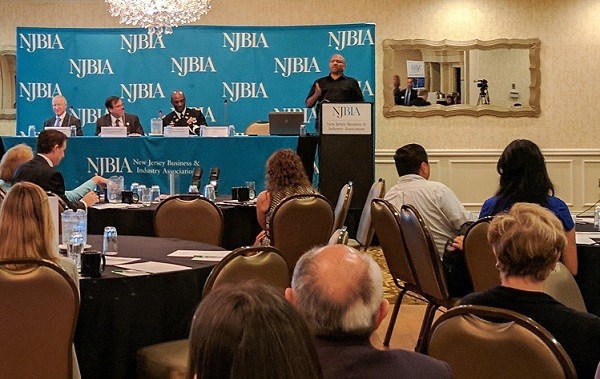At the NJBIA Summit, a Look at How Innovation Gets Done, Part 1

[At the end of September, the New Jersey Business & Industry Association (Trenton) held its Innovation Summit, which featured four speakers who gave the audience glimpses into their work. In Part 1, we cover Ramarao Garikapati, director of the Anheuser-Busch InBev TechNWK Incubator, and Col. James E. Martin Jr., Commander of Army Support Activity at Fort Dix and Deputy Commander at Joint Base McGuire-Dix-Lakehurst.]
The NJBIA held its 2017 Innovation Summit on September 27, inviting policy makers and regulators, members of the business community, academic leaders, and nonprofits to participate in a dialogue about advancing the innovation agenda in New Jersey.
According to Michele Siekerka, the president and CEO of NJBIA, “When we get up every day at NJBIA, we have a vision to have New Jersey reclaim its stature as an innovation state. That’s why we’re here today.”
Donald H. Sebastian, president and CEO of the New Jersey Innovation Institute, at New Jersey Institute of Technology, also shared his thoughts, arguing that New Jersey’s nickname, “the Garden State,” should instead be something more reflective of the state’s manufacturing roots. “We were the first manufacturing site, we were the birth of innovation, and continue to be a source of innovation in this country,” he said.
The event brought together a panel of four unique industrial leaders based in New Jersey to discuss how their companies or organizations are working to be more innovative, using disruptive technologies to ensure that they take advantage of 21st-century technological changes, rather than being overwhelmed and swept away by them.
Ramarao Garikapati
Director of the Anheuser-Busch InBev TechNWK Incubator
AB InBev is a global company based in Belgium that focuses on mainstream and craft beer products. Its Newark brewery was added in 1951. Although beer remains at its core, the company has invested in several innovation-focused areas. ZX Ventures, in New York, and the AB InBev Beer Garage, in Silicon Valley, are two examples of the company’s attempts to use changing technologies to find new solutions for developing, delivering and marketing its products.
The TechNWK Incubator, founded this year, is AB InBev’s new tech-supply incubator, and it’s based at the company’s Newark location. This venture focuses on operations, especially on finding more efficient uses of existing technologies to improve processes. Garikapati stressed that the overarching problem remains one of too few ideas and too-slow processes. The program aims to drastically reduce the time needed to turn new ideas into solutions, and to shorten production from the typical several years to an average of under three months.
The TechNWK Incubator has three programs: Hackathons, Agile Innovation Sprints and Tech Supply Pilot Cohorts. Hackathons involve projects lasting anywhere from two days to a month. Under this program, TechNWK cosponsors efforts by local startups and tech companies to find solutions to problems they are facing; the challenge and time crunch tend to inspire innovative approaches. Agile Innovation Sprints take an even more rapid approach, with prototype-development projects taking no more than a week. Lastly, the Tech Supply Pilot Cohorts program involves bigger, longer projects: They span two to three months and seek to build a community of tech partners tackling common problems and even detecting these problems before they surface.
Garikapati said that he strives to continue “making innovation part of our daily lives, and pushing on with building a community-based approach.”
Colonel James E. Martin Jr.
Commander of Army Support Activity at Fort Dix and Deputy Commander at Joint Base McGuire-Dix-Lakehurst
Col. James E. Martin Jr. discussed how the government is using innovation to strengthen national security. Martin reminded his listeners that the U.S. Army must have a specific purpose when it innovates. Part of its purpose now is to look for threats over the horizon and on future potential battlefields, as far out as 2050. The Army uses special techniques to determine what kinds of challenges its soldiers will be facing, and figures out how to best equip them to handle any situation that may be thrown at them by their adversaries.
Martin explained that the U.S. military must be able to conduct a Multi-Domain Battle (MDB). What used to be an approach encompassing land, air, and sea, is now being extended to the space, cyber, and electromagnetic spheres. It is the Army’s job to find approaches that will leverage all of these terrains in order to defeat or prevent enemy attacks.
The United States Army Research, Development and Engineering Command (RDECOM) is the innovation branch of the Army, and directs a lot of these efforts. Housed under RDECOM is the United States Army Communications-Electronics Research, Development and Engineering Center (CERDEC), which is currently testing new ideas developed under the parent program in such areas as night vision, antennas, cyber security, countering improvised explosive devices (IEDs), communications/networks and jamming/antijamming. New technologies are field tested: Soldiers are instructed to break the equipment, see what works and what doesn’t, and report the results back to the Pentagon for evaluation.

